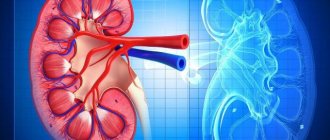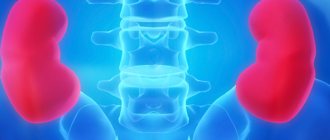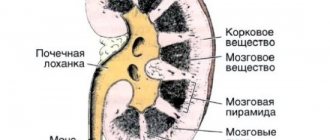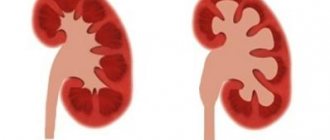Malformations of the genital organs
Diagnosis of simple variants of the defect is not difficult. A standard examination for suspected obstruction of the vagina and cervix, in addition to general clinical and laboratory tests, includes anamnesis, assessment of physical and sexual development, examination of the external genitalia, bacteriological and bacterioscopic examination of discharge from the genital tract, rectal-abdominal examination, vaginal probing, ultrasound reproductive and urinary systems. As a rule, these studies are sufficient to accurately determine the type of defect and choose the method of surgical intervention.
On objective examination, the vaginal vestibule and hymen appear normal. Even with total aplasia of the vagina, its vestibule is preserved. Only with atresia of the hymen does its appearance differ from the usual one. When pressing on the anterior abdominal wall above the pubis, the hymen bulges in the form of a cyanotic dome.
Bacteriological and bacterioscopic examination of discharge from the genital tract provides significant information mainly in case of fistulous vaginal atresia, when purulent discharge serves as an indirect diagnostic sign, and test results are necessary for rational antibacterial therapy.
A round, elastic, low-painful and inactive formation palpated during rectal-abdominal examination, pushing the uterus upward, is usually a hematocolpos. Pressure on the hematocolpos is transmitted through the rectum to the uterus and is felt upon palpation above the womb. The displacement of hematocolpos is limited; how does it differ, for example, from an ovarian cyst, which has a similar location, consistency and shape.
Vaginal probing is aimed at determining the depth of the lower part of the vagina and is carried out simultaneously with a rectal-abdominal examination. The distance from the top of the vaginal dome to the bottom of the hematocolpos allows you to accurately determine the diastasis between the sections of the vagina, assess the reserves of plastic material and outline the surgical plan. The distal part of the vagina is often represented by one vestibule and has a depth of about 1-2 cm. Less often, the depression behind the hymen is less than 1 cm.
Ultrasound examination (ultrasound) of the internal genitalia documents the correct interpretation of clinical data. The study is carried out with a full bladder with the sensor located above the pubis and in the perineum. At the same time, the organs of the abdominal cavity and retroperitoneal space are examined. Ultrasound allows you to reliably determine the size of the uterus and its cavity, the thickness of the endometrium, the size and thickness of the walls of the hematocolpos, the distance from its bottom to the skin of the perineum. At the same time, the reliability of ultrasound is quite high only in diagnosing the simplest forms of the defect - low vaginal atresia without organ duplication. In all doubtful cases - if there is a discrepancy between the history, clinical picture and examination results, ultrasound data should be checked by other methods - endoscopy, magnetic resonance imaging (MRI). In some observations, laparoscopy and vaginography are the most informative.
In the diagnosis of complex or atypical vaginal malformations, preference should be given to magnetic resonance imaging. No special preparation is required for MRI. The study is carried out with the patient in the supine position in frontal, sagittal and axial projections. For vaginal atresia and aplasia, the most informative for clarifying the anatomical structure is the sagittal projection, which makes it possible to accurately determine the amount of diastasis between the vaginal sections, the size of the hematometra and hematocolpos, and to assess the condition of the cervix. However, when the vagina and uterus are duplicated, sagittal sections do not allow one to easily reconstruct the anatomical relationships of the organs. In the case of duplication of the reproductive tract, a study in the frontal projection is more informative. In recognizing many complex anomalies of the internal genital organs, MRI provides the most valuable information that predetermines the choice of surgical intervention.
Ultrasound and MRI data for fistulous vaginal obstruction may vary depending on the time of the study and the degree of filling of the vagina with contents. Evacuation usually occurs during a rectal-abdominal examination. Pyocolpos may empty spontaneously during anti-inflammatory therapy. Erroneous interpretation of MRI data is possible with an “empty” vagina.
In diagnosing an “empty” vagina in fistulous forms of atresia, vaginography is more informative than ultrasound and MRI. Before the advent of ultrasound and MRI, vaginography was the only examination of the vaginal cavity above the level of obstruction. However, vaginography is associated with a high risk of infection of the proximal vagina with closed hematocolpos. Currently, vaginography is advisable to use only in the fistulous form of vaginal atresia as a documentation study.
Endoscopic examinations of the lower urinary tract (sinus-urethrocystoscopy), as well as urodynamic studies, are indicated for children with combined genitourinary pathology (iatrogenic urethral damage, persistent urogenital sinus, cloacal anomalies).
Thus, clarification of the anatomy of the malformation, necessary for choosing surgical tactics, is possible only with a comprehensive examination, including radiological and endoscopic methods. MRI remains the most informative clinical method for studying the pelvic organs.
Diagnostic difficulties in case of obstruction of the vagina and cervix are confirmed by the high frequency and variety of diagnostic errors made by both gynecologists and doctors of other specialties.
The primary stage of diagnosis for congenital obstruction of the vagina and cervix almost always causes difficulty and rarely ends in establishing the correct diagnosis. The disease often manifests itself quite unexpectedly, beginning with acute abdominal pain, urinary retention or the appearance of a tumor-like formation in the abdominal cavity, which often causes urgent laparotomy.
Many adolescent girls with congenital vaginal obstruction first undergo an appendectomy for suspected acute appendicitis before being properly diagnosed. This is due to sharp abdominal pain, which often leaves the surgeon in no doubt about the need for emergency surgery. Ultrasound allows you to avoid unnecessary appendectomies.
Incorrect diagnosis of mucocolpos in infants can lead to serious consequences. Suspicion of a tumor or cyst in the abdominal cavity provokes the surgeon to perform a wide laparotomy with removal of the upper part of the vagina.
Acute urinary retention or pus in the urine (pyuria), which occurs with fistulous pyocolpos, requires a urological examination. A child can become a “traveler” for a long time in urological hospitals.
Errors often occur with complete doubling of the uterus and aplasia or atresia of one half of the doubled vagina. It is most difficult to determine the second closed vagina when there are two kidneys, since complete doubling of the uterus and an additional closed rudimentary vagina are accompanied by agenesis of one kidney.
Due to acute pain in the lower abdomen with vaginal obstruction, the hematocolpos is often opened and its contents are evacuated. Such an intervention, especially with high hematocolpos, is associated with a significant risk of damage to the urethra, bladder and rectum and can lead to the development of pyocolpos, pyometra and peritonitis. There are no emergency indications for emptying hematocolpos. The female genital tract has great adaptive capabilities, and pain therapy (baralgin, maxigan) is often sufficient to relieve or relieve pain. Surgical interventions can only be performed by specialists, preferably in patients during the intermenstrual period.
Risk factors for the development of congenital anomalies of the urinary system
Introduction. Congenital malformations of the urinary system (UC) account for more than 50% of all abdominal developmental anomalies in newborns and occur in approximately 0.5% of all pregnancies [1,2]. Despite the development of prenatal diagnosis and the possibility of early surgical intervention, anomalies in the development of CMS are still the main cause of the development of renal failure in newborns [3,4]. The development of prophylactic and preventive nephrology is a priority in pediatrics and is based on recognizing risk factors (RFs) for compulsory medical conditions, assessing the risk of disability and carrying out a set of measures for the prevention of kidney diseases, early diagnosis of congenital pathology of compulsory medical conditions and rehabilitation of patients [5-8]. The accumulation of data on individual risk factors that contribute to the development of kidney pathology makes it possible to counter this pathology by controlling risk factors in children at the stage of borderline conditions [9]. To do this, it is necessary to know the frequency of kidney pathology, regional characteristics of RF in children, taking into account age, gender, hereditary factors, and exogenous influences [10,11]. The lack of an unambiguous assessment of the etiological and pathogenetic significance of the factors influencing the formation of congenital kidney malformations (CRMD) and the effectiveness of clinical and prognostic criteria for the occurrence of CMRD determined the goal and objectives of this work.
Purpose of the study: to increase the efficiency of early diagnosis and prognosis of CPRP based on assessing the significance of risk factors.
Research objectives:
1. Assess the role of social and everyday factors in the formation of the long-term potential of compulsory medical insurance.
2. To study the role of hereditary factors in the formation of congenital malformation of compulsory medical insurance.
3. Determine the role of obstetric and gynecological history in the formation of compulsory health insurance.
Materials and methods . 130 children were examined and divided into 3 groups: group 1 included 50 children with vesicoureteral reflux (VUR), group 2 included 40 children with hydronephrosis, while group 3 included 40 healthy children. At the first stage of the examination of children, the method of questioning parents was used using a specially developed questionnaire to identify social and medical-biological risk factors, including controllable, poorly controllable and uncontrollable, as well as social and hygienic factors of the family’s conditions and lifestyle; An analysis of the genealogical, medical and biological history, and an assessment of physical and sexual development were carried out. The collection of information about each child was supplemented with data from medical records, as well as data from the archives of the maternity hospital. The questionnaire included questions regarding the serial number of pregnancy, the age of the parents, occupational hazards before the birth of the child from the parents, illnesses of the mother during pregnancy, complications during pregnancy, taking medications during pregnancy, the date of delivery and hereditary burden.
Research results. Some nosological forms of congenital malignancies are associated with additional social and everyday factors, which are realized both through women, by directly influencing the fetus during pregnancy, and through men, having a mutagenic effect on spermatogenesis. The dependence of the child’s condition on the age of the parents at which he was conceived is well known. In our study, in all 3 groups, the age of the parents predominated from 18 to 40 years, and was 70.0% in mothers and 86.0% in fathers in the group with PMR, 67.5% and 87.5 in the group with hydronephrosis % in mother and father, respectively, and in the control group 72.5% and 77.5%, respectively. It was found that in children with hydronephrosis, the mothers' age was statistically significantly more often over 40 years old (p<0.05), which emphasizes the need for careful monitoring of children born to mothers in this risk group (Table 1). The occupational hazards of parents play a certain role in the formation of congenital problems. When analyzing occupational hazards, the following results were obtained: in children of groups I and II, mothers were statistically significantly more likely to work in production associated with exposure to salts of heavy metals, as well as chemical factors, while in the control group no similar trend was identified (p<0. 05) (Table 1). At the same time, work associated with exposure to high temperatures, industrial dust, vibration, and also associated with heavy physical labor does not have a statistically significant impact on the formation of compulsory health insurance.
Table 1. Prenatal risk factors for the development of malformations of the urinary system.
Note: hereinafter * - p<0.05 - statistically significant differences between the 1st, 2nd and control groups.
We also analyzed the family history. It was found that the leading risk factors for the formation of compulsory medical insurance in children are the presence of kidney disease in the family, especially in the mother. Thus, in relatives of children with PMR, polycystic disease was more common than other kidney defects; hydronephrosis was also common, while kidney defects such as a solitary kidney, duplex kidney, hypoplasia, dystopia and rotation, fused kidney and solitary cyst were practically not encountered. In children with VUR, kidney defects were statistically significantly more common in mothers (32%) than in grandparents (p<0.05). In children with hydronephrosis, relatives were statistically significantly more likely to have hydronephrosis (p<0.05), while other developmental defects were practically not encountered. At the same time, women (mothers, grandmothers, sisters) were more likely to suffer from hydronephrosis. In children of group 3, no statistically significant differences were revealed when analyzing the presence of CMS defects in the anamnesis. Features of the obstetric and gynecological history and the course of pregnancy determine the nature of intrauterine development of the fetus and the formation of a certain congenital malformation of compulsory medical insurance. The course of pregnancy has a great influence on the development of the fetus. Conditions of hypoxia and insufficient nutrition are created for the embryo during bleeding, threatening miscarriages, and severe toxicosis of pregnancy. When analyzing the course of pregnancy in women whose children were included in this study, a tendency was found to increase the percentage of pregnancy complications in the presence of congenital kidney pathology in the fetus (p <0.05). Very little is known about the safety of medications during pregnancy. For ethical reasons, randomized studies involving pregnant women are extremely rare, and in widespread practice, doctors do not track pregnancy outcomes when prescribing medications. Most mothers of children included in the study did not use any medications during pregnancy. Thus, in the control group, 34 women reported not taking medications during pregnancy, while mothers whose children suffered from PMR and hydronephrosis had a higher percentage of taking medications (p < 0.05 compared to the control group) . The most frequently used drugs were hormonal drugs (20%, 10% and 5%, respectively, by group), diuretics (6%, 7.5% and 2%, respectively), antipyretic drugs (8%, 10% and 5% in the first, second and control groups, respectively), as well as antibiotics (8%, 7.5% and 2.5% in groups I, II and control, respectively). When analyzing somatic pathology, it was revealed that mothers of children with VUR and hydronephrosis were statistically significantly more likely to suffer from acute respiratory viral infections (ARVI) in the first trimester of pregnancy (34% and 30%, respectively) (Table 2).
Table 2. Risk factors for the development of malformations of the urinary system during pregnancy
Delivery at 38 to 42 weeks was observed in 34 (68%) women in group I, 30 (75%) women in group II and 36 (90%) women in the control group, which indicates a higher prevalence of premature and late births. childbirth in the presence of renal pathology in the fetus, which is also consistent with the higher prevalence of pregnancy complications in these groups. Thus, in the course of the study, the multifactorial nature of the occurrence of CHI defects was revealed. In a multivariate analysis of social biological factors, it was found that the leading risk factors for the formation of compulsory medical insurance in children are the presence of kidney disease in the family, especially in the mother; complicated antenatal period and obstetric history of the mother (complicated pregnancy, previous miscarriages, etc.); occupational hazards, taking medications. The frequency of teratogenic effects, including the influence of drugs, occupational hazards, and infectious diseases (ARVI) during pregnancy in mothers of children with developmental defects of compulsory medical syndrome was statistically significantly higher than in mothers of children in the control group (p <0.05). Women who, due to the nature of their work, have contact with active chemical factors and heavy metal salts should plan pregnancy. 2-3 months before conception and the entire period of pregnancy (especially up to 14-16 weeks), it is advisable to avoid contact with chemicals that can cause a teratogenic effect in the fetus. It is necessary to prescribe medications to pregnant women according to strict indications, only if the expected benefit outweighs the possible risk to the fetus, using drugs with established safety and long-term experience of use in pregnant women, and in minimal effective doses. It is also necessary to regularly monitor the use of drugs during pregnancy and compliance of drug therapy with recommendations based on evidence-based medicine in order to improve its quality and safety, as well as avoid the occurrence of developmental defects of compulsory medical conditions.
Conclusions. Women at risk require a targeted examination, rational pregnancy management tactics, and timely detection of congenital malformations of the fetus. Important components of health-improving measures are: appropriate preparation of girls of fertile age, prevention of exposure to harmful factors on the fetus, careful collection of anamnesis, effective observation and treatment at the outpatient stage.





